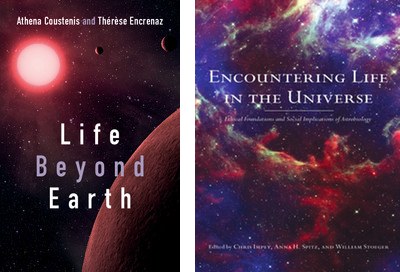Review: Two books on astrobiologyby Jeff Foust
|
| “[I]t cannot be ruled out that life may have emerged on or in Titan at some point in its history, in spite of the extreme and inhospitable conditions of its current environment,” Coustenis and Encrenaz conclude. |
As the subtitle of Life Beyond Earth: The Search for Habitable Worlds in the Universe suggests, authors Athena Coustenis and Thérèse Encrenaz, two planetary scientists, focus more on the “astro” of astrobiology. “Here we will not deal so much with the search for life itself,” they write early in the book, “but rather with the habitability conditions that we can find in the Solar System and beyond, in other stellar systems.” And while they do devote one chapter to biology, the rest of this book is devoted to studying the potential for other worlds in our solar system and beyond to support life.
While Mars, and to a lesser extent Jupiter’s moon Europa, get the most attention as potentially habitable worlds in the solar system, Coustenis and Encrenaz see plenty of other locales that at least have, or had, the potential to support life, including Jupiter’s moon Ganymede and the Saturnian moons of Titan, and Enceladus. They are particularly intrigued by Titan and its ample supply of organic compounds that could provide the building blocks of life. “[I]t cannot be ruled out that life may have emerged on or in Titan at some point in its history, in spite of the extreme and inhospitable conditions of its current environment,” they conclude.
Studying the potential habitability of Titan, or other worlds in the outer solar system, is particularly challenging, given the difficulties—and costs—of sending missions there. The last chapter of the book briefly discusses those proposed missions, like ESA’s JUICE mission to Jupiter in the 2020s, but oddly spends more time studying the benefits, or lack thereof, of human spaceflight. The authors are not particularly fond of it, arguing that there are “very sound reasons” to oppose human missions like limited scientific return, but seem resigned that such missions will take place regardless.
That last chapter also briefly explores some of the issues associated with planetary protection, including contamination of habitable worlds by terrestrial spacecraft. That potential interaction of terrestrial and extraterrestrial life is the subject of Encountering Life in the Universe, a collection of essays based on a workshop held in Arizona in 2008. The focus here is less on the scientific issues of the discovery and study of extraterrestrial life, but the ethical issues posed by such potential encounters.
| Sullivan advocates for what he calls “planetocentric ethics,” whose central tenet is to “cause neither physical nor biological harm to any planetary body and its ecosystems.” |
The book casts a broad net in the examination of that issue. Philosophers and theologians approach the issue from different points of view, invoking both Western and Eastern belief systems in the study of what some authors call “astroethics.” Scientists look for parallels of astrobiological ethics with concerns about the development of artificial life forms on Earth. In another essay, NASA astrobiology Chris McKay argues that astrobiology also includes the issue of the future of life in the universe, and that “the long-term goal of astrobiology and society to be to enhance the richness and diversity of life in the Universe.” He uses that to discuss his concept of “biologically reversible” exploration of Mars, should we find evidence of current life there that evolved independently of Earth (see “Cleaning up after Martian exploration”, The Space Review, August 25, 2003).
While McKay advocates the extension of terrestrial life beyond Earth provided it does not interfere with non-terrestrial life, another contributor to the book advocates a more (human) hands-off approach to exploration. Woody Sullivan of the University of Washington advocates for what he calls “planetocentric ethics,” whose central tenet is to “cause neither physical nor biological harm to any planetary body and its ecosystems.” He advocates for a treaty regime similar to the Antarctic Treaty that limits human activities in the solar system to scientific ones. “The Solar System is our last great wilderness,” he writes. “We must begin now to act to keep it untrammeled by human action.”
Many would, no doubt, disagree with Sullivan’s absolute ban on keeping even asteroids and barren moons “untrammeled” by human activity, for denying humanity the vast resources that are potentially available beyond Earth might well threaten humanity’s long-term survival. But that diversity of viewpoints is what makes Encountering Life in the Universe an interesting book; as one of the essays notes, “This chapter has raised more questions than it has answered.” That’s fitting, since astrobiology is still a young field, and answering questions may be less important now than figuring out what questions to ask.
